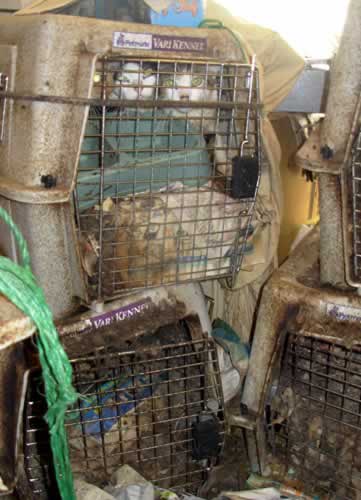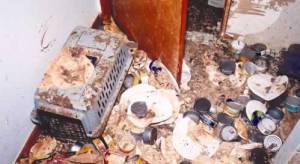
- Ruth Knueven and her 488 cats — 222 of them dead, and most of the others so wild and sick that they had to be euthanized.
- 800 dogs seized from mobile home of elderly couple outside Tucson, Arizona.
- Police in Chester Township, New Jersey found 80 cats and 1 dog in a million-dollar home that was full of animal feces up to 2 feet deep in some parts of the house.
- A man who’d previously faced animal hoarding and cruelty charges was found holed up in a motel room with 21 cats.
And the stories go on and on. When you read about someone who is hoarding animals, think HORRIBLE, for that’s what it usually is. And it’s horrible for everyone involved. The hoarders, the animals, the shelters who now get the pets and the rescuers who have to face the filth, the stench, the dead and dying.
The saddest part is that in the majority of these situations, the people who are found hoarding these animals started doing so out of love of them.
It’s true.
Most animal hoarders start out rescuing their victims, caring for them as best as they can. They feel an obligation to save these poor unfortunate creatures from life in a shelter, abandonment or euthanasia.
All too quickly things spiral out of control for the hoarder and their ability to care for the animals they purport to love.
It’s too much for them, and the pets begin to suffer from lack of medical care, food and love.
But rather than seek help, hoarders typically choose to ignore the bad parts and focus on the ‘good’ they are doing for these poor creatures. Typically they become caught up in the overwhelm of doing what little they can for the animals that when one is sick or dies, they are too overwhelmed to dispose of the body – so these will be stashed somewhere or put in a freezer until they have time to take proper care.
That time never comes and things continue to accumulate.
Now the rescued need rescuing but, due to the nature of animal hoarding, the problem is usually hidden away behind closed doors and no one knows there is a problem until the problem is so far out of hand the authorities have to be called in to resolve it.
In the video below you can see a typical situation:
In this case over 200 cats had to be euthanized, not because of ill health necessarily, but because they’d become feral cats and weren’t able to become socialized enough to be adoptable.

So sad and so unnecessary.
What it is:
The Human Society US defines an animal hoarder as a person who has more animals than he or she can properly care for.
Another defining characteristic is the hoarder’s denial of his inability to care for the animals and his failure to grasp the impact his neglect has on the animals, the household, and the human occupants of the dwelling.
An animal hoarder is someone who:
- Collects large numbers of animals.
- Denies those animals basic care such as adequate food, water, shelter, veterinary care and sanitary conditions in which to live.
What you can do:
If you know of someone who fits the above description, realize that the vast majority of time that person cannot tell that they are not taking proper care of the animals that have. It’s always wise to contact your local chapter of the humane society and report your suspicions and why you think there might be a case of animal hoarding.
If you are someone who has more animals than you can properly care for, you can also seek help from a local adoption agency, Humane Society or shelter. It’s not a crime to do something to take care of the problem yourself.
It is a crime if you do not.
Here are some additional resources for more information on the subject of animal hoarding:
http://en.wikipedia.org/wiki/Animal_hoarding
http://www.animalhoarding.org/